Listings
I. The Listings Verifier, Listing Accuracy, & Listing Detail Pages
One of the primary benefits of Yext Listings is that it syncs facts about your business to 200+ publishers in our publisher network . But naturally, every publisher has its own rules and processes for modifying and displaying the data that they receive. As a result, sometimes the data displayed on a listing will slightly differ from the data you stored in the Knowledge Graph.
Up until now, the only way to truly understand if a given publisher listing was reflective of your data in Knowledge Graph was to visit the listing on the publisher site and manually review each field. But of course, it was never realistic to expect any person to check every single listing on every single publisher on a regular basis.
Therefore, we built the Verifier in order to offer more transparency and convenience. The Verifier is a system that automatically scans the web and determines the accuracy of your listings. This system proactively flags any discrepancies between the data you provided and the data a publisher is displaying, removing all ambiguity and manual review from the process.
The data fetched by the Verifier is presented as a comprehensive table, which allows you to assess an individual listing’s accuracy. This table includes a side-by-side comparison of the Knowledge Graph data and the publisher’s data for every field, as well as a column that summarizes whether the publisher’s data for that field: is “Verified” to match the Knowledge Graph source, is still processing, or is a “Data Mismatch”.
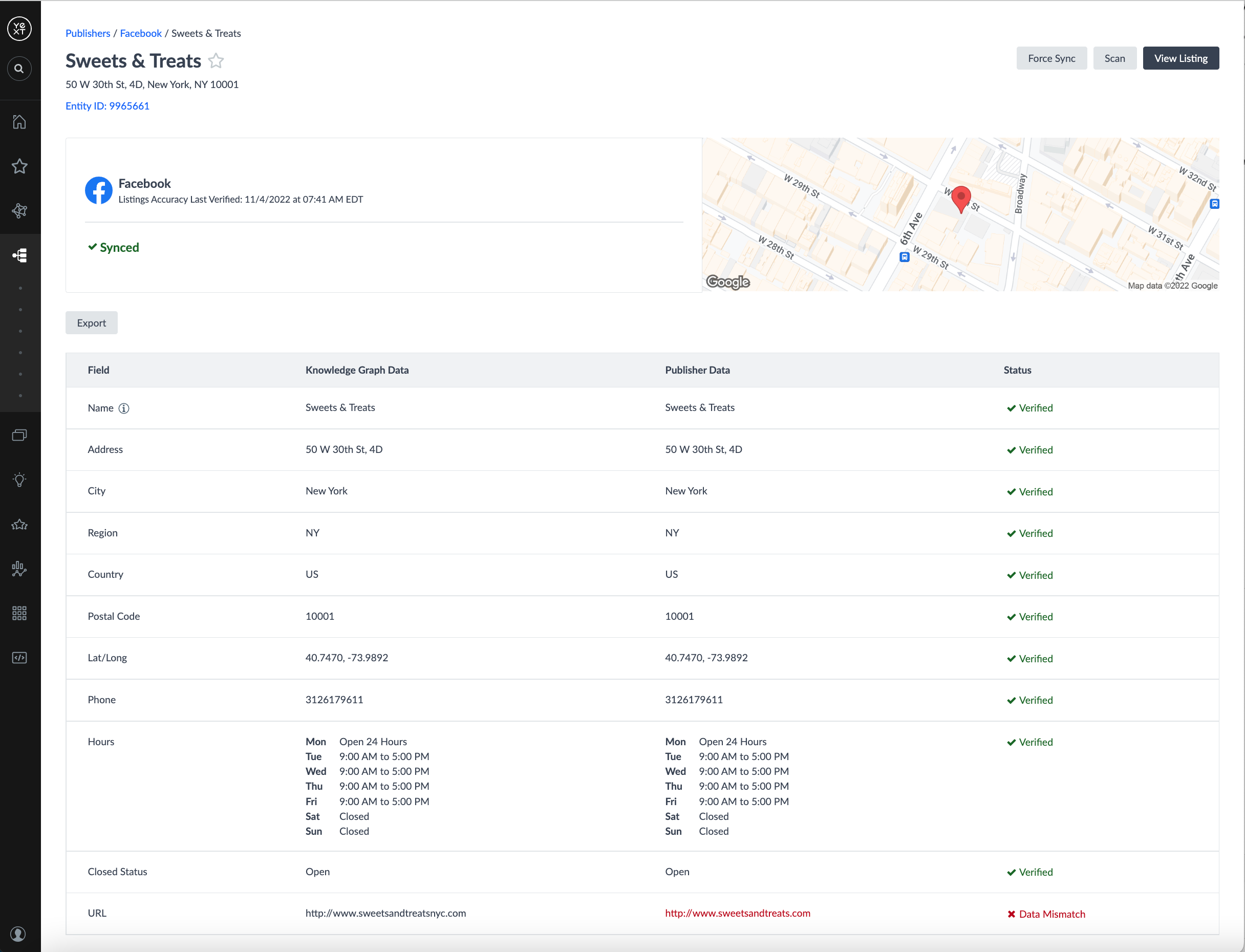
This detailed view of each field allows you to quickly confirm data matches, identify any reasons behind “Data Mismatches,” and take action if necessary. You will ultimately decide if:
There is no action needed — On some occasions, the discrepancy can be due to a minor change, such as the publisher removing an unsupported symbol. In these cases, you may choose to simply stay informed of these changes without taking any action.
There is publisher action needed — If the publisher is missing important data or displaying incorrect data, you can either “Force Sync “ or escalate the problem through Yext.
There are content updates needed — If you realize that the publisher is displaying more accurate or complete data than you had stored in Knowledge Graph, you may want to update Knowledge Graph to include these improvements.
Regardless of impact, the Verifier ensures that you’re aware of any single instance that your listing does not exactly match the data you sent to a publisher.
Lastly, all of this helpful information about Listing Accuracy can be found on each listing’s dedicated Listing Detail Page. This new page provides a destination where you can find in-depth information, like status and Listing Accuracy, for every single listing in your account.
Note: These new features are currently only supported on select publishers, such as Google, Facebook, and Yelp. For a full list of supported publishers, please visit our reference documentation.
To turn this feature on in your account, navigate to Account Settings > Account Features and select Fall ‘22: Listing Detail Pages (early access)
To learn more about the Listings Verifier, Listing Accuracy, & Listing Detail Pages, check out our reference documentation.
II. Listings Accuracy in Report Builder
Businesses will also be able to track “Listings Accuracy” as a metric in Report Builder, in order to understand how well their Knowledge Graph data matches publisher data at scale. This metric is defined as “the percent of fields with accurate data on Listings,” with “accurate” meaning an exact match to the data stored in Knowledge Graph.
This metric can be dimensioned by the following:
- Entity
- Time
- Field
- Publisher
For example, a business could use Report Builder to understand the accuracy of each field for a specific location across its listings presence (by dimensioning by field and filtering by entity), in order to identify specific field values that may need attention.
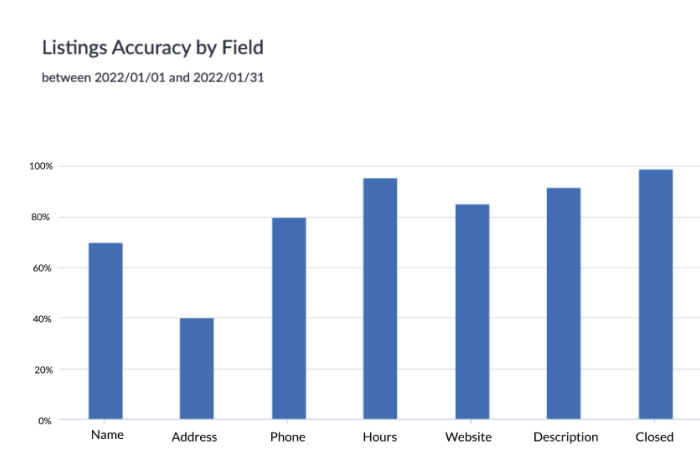
To turn this feature on in your account, navigate to Account Settings > Account Features and select Fall ‘22: Listing Accuracy Metrics (early access)
To learn more about Listings Verifier, Listing Accuracy, & Listing Detail Pages, check out our documentation
III. Google Place Actions (Food)
Google now allows restaurants to provide two differentiated food ordering URLs — one for pickup orders and one for delivery orders.
Users will be able to set the following fields in Knowledge Graph:
- Order URL which maps to Google’s FOOD_TAKEOUT Place Action
- Delivery URL which maps to Google’s FOOD_DELIVERY Place Action


These newly accepted Food Place Actions allow businesses to contribute first-party links that will appear in the food.google.com ordering experience after the user clicks the primary “ORDER ONLINE” Call-to-Action on the listing’s knowledge card.
Sending Food Place Actions links through Yext’s API will:
- Ensure customers see a conversion-driving, blue “ORDER ONLINE” button (if it was not previously showing up on the GBP listing)
- Remove ambiguous warnings like “May offer pickup” or “May offer delivery” from the listing that cause uncertainty about ordering availability
- Provide Google with additional confidence about the listing’s accuracy, which may improve a business’ rank in search
Note: The existing Order URL field in the Knowledge Graph will be mapped to Google’s FOOD_TAKEOUT Place Action. This means that all data currently stored in the Order URL field will automatically be synced as FOOD_TAKEOUT Place Actions on Google Business Profile.


To turn this feature on in your account, navigate to Account Settings > Account Features and select Fall ‘22: Google Place Actions Fields (early access).
To learn more about Google Place Actions, visit our documentation.
IV. Social Posting for Instagram
Users can now post to Instagram Business Accounts via the Yext Posting UI or Social API.
Functionality includes:
- Creating an Instagram post with a caption and single photo
- Managing comments on an Instagram post (view, add comment, reply to comment, delete comment)
- Viewing the following insights on posts:
| Field in Yext API | Meaning | Availability |
|---|---|---|
likeCount* | Sum of likes, comments, and users who saved the post | Social API Only |
viewCount | Total number of times the post has been seen | Social API Only |
uniqueViewCount | Total number of times the post has been seen by unique users | Social API Only |
Additionally, there are a series of changes to the Comment Endpoints in the Social API to support comment management of these posts. These changes include:
- Support for a new “Comment: Delete” endpoint in the Social API
- Renaming of “Entity Post: Create Comment” to “Comment: Create”
- Support for responding to Instagram comments
The “Comment:Delete” endpoint and the “Comment:Create” endpoint can be used for both Instagram and Facebook posts. Responding to comments, however, is only available for use with Instagram.
Note: In order to access Instagram posting in Yext, users will need to have a linked Facebook account and active Facebook page (listing).
As a reminder, all new publishers (including Instagram) will be available starting on the General Availability Date, December 15th, 2022.
V. Social Posting for Twitter
Users can now post to Twitter accounts via the Yext Posting UI or Social API.
Functionality includes:
- Creating a Tweet with a caption and single photo
- Viewing the following insights on posts (only available via Social API):
| Field in Yext API | Meaning | Availability |
|---|---|---|
likeCount* | The number of times the post was liked | Posting UI or Social API |
viewCount | The number of times the post was viewed | Social API Only |
retweetCount | The number of times the post was retweeted | Posting UI or Social API |
quoteCount | The number of times the post tweeted as a quote | Social API Only |
replyCount | The number of replies the post received | Social API Only |
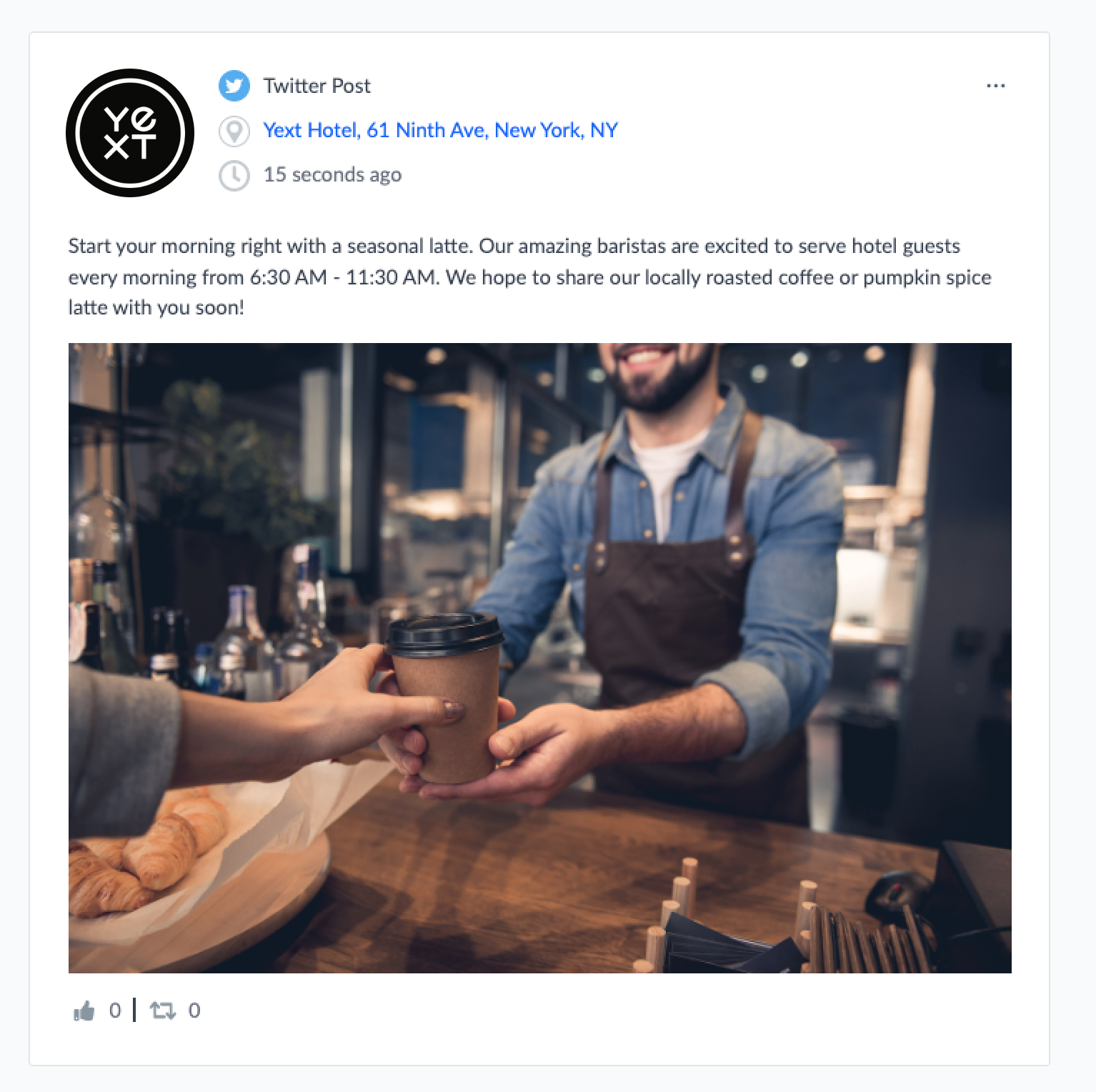
As a reminder, all new publishers (including Instagram) will be available starting on the General Availability Date, December 15th, 2022.
VI. LinkedIn - Extended Access Token Lifecycle (Partner only)
Partners who use Yext Posting for LinkedIn will now benefit from their LinkedIn account being valid for 365 days before it needs to be re-linked to Yext. Previously, accounts needed to be re-linked every 60 days.
This improvement has been added, so you can start taking advantage of it today.
VII. LinkedIn - Post Deletion (Partner only)
Partners who use LinkedIn posting can now delete posts directly from the Yext platform.
Post deletion on LinkedIn will be available starting on the General Availability Date, December 15th, 2022.
VIII. Google Business Profile Posts - Renamed ‘Shop’ CTA to ‘Buy’
We are renaming the ‘Shop’ Call-to-Action within the Yext Posting UI and API for Google Business Profile posts to ‘Buy’, in order to more accurately reflect the appearance of this CTA on Google.
This update has been automatically enabled, so you will see this in your account today.
IX. Google Call History Analytics
In the Summer ‘22 Release, we introduced the ability for users to toggle on or off Google Call History from the Yext platform. Users could then log in to Google Business Profile to see a breakdown of their business’ answered vs. missed calls.
This release, users can now view these Call History analytics metrics directly in Yext’s Report Builder. These metrics include:
- Answered Calls, which can be dimensioned by:
- Month
- Missed Calls, which can be dimensioned by:
- Month
- Day of Week
- Time of Day
Note: Due to Google’s restrictions , Google Call History Analytics are currently only available for businesses in the United States or Canada.

navigate to Account Settings > Account Features and select Fall ‘22: Google Call History Analytics (early access).
To learn more about this feature, visit our Google Call History reference doc.
Reviews & User-Generated Content
I. Support for Third-Party Publishers in Review Submission API
Developers can now request to build custom review monitoring integrations with third-party publishers. This can unlock new review sources that are not natively supported in Yext. For example, if your customers leave reviews on an industry-specific third-party platform, you could now build an integration with that publisher to fetch reviews from the third-party, and add them into Yext via the Review Submission API.
Outside of any custom-built cases, Yext will continue to offer best-in-class review integrations with the most popular 3rd-party review platforms like Google, Yelp, TripAdvisor to all Reviews customers.
Any developers interested in building custom review integrations should reach out to their account team for additional information.
Note: Custom-built integrations can only support Review Monitoring, not Review Response or Generation.
For more information on the Review Submission API, visit our Documentation.
II. Send Single Invitation Entity Picker Improvement
When sending a single review invitation, users can now locate a single entity nested underneath a Knowledge Graph folder or label. This will improve the review generation user experience in situations where an account has complex Knowledge Graph foldering or labels.
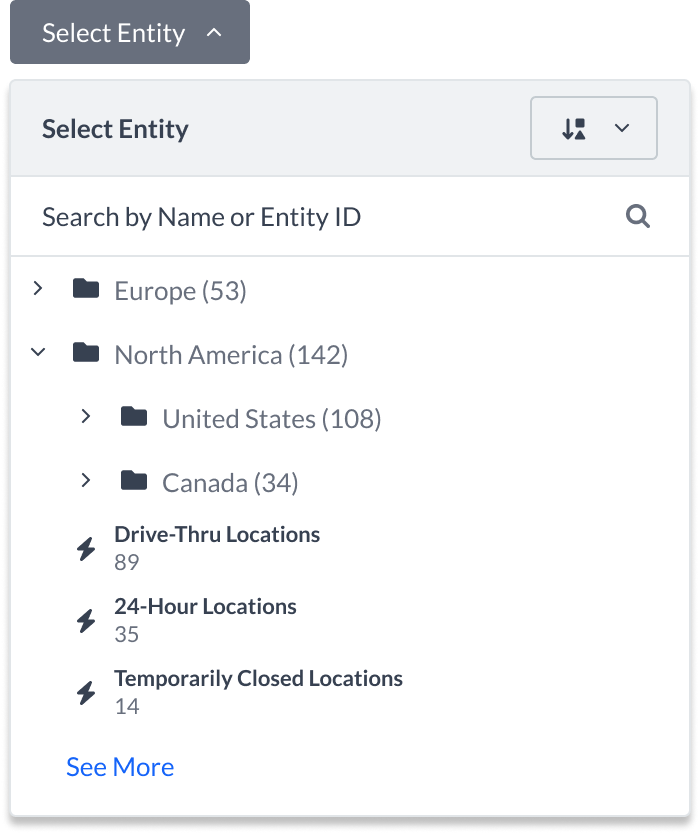
This feature was automatically enabled in all Sandbox and Production accounts, so you can start taking advantage of it today!
To learn more about Sending a Single Review Invitation, visit the Send a Single Review Invite help article.
III. Review Labels Included in Review Webhooks
Review labels will now be included in review webhook notifications to improve API-based reviews workflows. The format of a review webhook notification now matches the format in Review: Get and Reviews: List API calls.
For more information, visit our API documentation.
Knowledge Graph
I. Select Events for Suggestion Notifications
To help users tailor their Knowledge Graph Suggestions and Approvals notifications as well as minimize the number of unwanted alerts, we have added additional configuration options. This additional step allows users to choose specific events for which they want to receive notifications.
For both Suggesters and Approvers, users can select to be notified for any set of the following Suggestion events:
- Assigned
- Approved
- Rejected
- Comment created
- Content updated
- Canceled
- Locked
- Unlocked
- Invalidated
For example, suggesters may only want to be notified when their suggestion is Approved, Rejected, or if another user comments on the suggestion. If a suggester does not want to be notified every time their suggestion is assigned to a new user/user group or locked/unlocked for review, they can now customize these settings to their preference.
To turn this feature on in your account, navigate to Account Settings > Account Features and select both Fall ’22: Notification Updates for Suggestions & New Entities (early access) and Fall ‘22: Notification Management Redesign (early access).
II. Improved Notifications for Newly Created Entities
This fall, we have made it even easier for users to stay up to date when new entities are created. Notifications were previously only available for new entities created via API, but are now available for entities created via any interface (e.g., single entity add, connectors, and file upload).
This improvement provides you with a comprehensive overview of new content being added to the platform in real-time.
For example, as an account administrator, you now have full visibility over newly created entities regardless of the method by which they were added. This new functionality is especially useful if you wish to take some manual action or perform periodic reviews of newly created entities.
To turn this feature on in your account, navigate to Account Settings > Account Features and select both Fall ’22: Notification Updates for Suggestions & New Entities (early access) and Fall ‘22: Notification Management Redesign (early access).
III. Entity History in Logs API
In the Spring ‘22 Release, we introduced the Logs API which allows users to fetch, filter, and sort various logs of the events conducted on their Yext experience(s). With this release, we have expanded the scope of the Logs API to serve entity history data. These logs will detail event-level entity updates, creations, and deletions, enabling users to see the logs of all changes made to entities in near real-time. This API will ensure that businesses can have full visibility into the history of updates made to entities, and can export this data from the Yext Platform programmatically.
For details on the Logs API visit our API Documentation.
IV. Apply Templates in Entity Language Profiles API
We have added support in the Entity Language Profiles: Upsert API endpoint to specify a template. Now, users are able to programmatically apply templates to alternate language profiles via API. This enhancement will be beneficial for developers building applications in accounts leveraging KG’s multi-language features.
For details on the Entity Language Profiles API visit our API Documentation.
V. Support for YouTube Shorts URLs
With this release, we have added support for YouTube Shorts URLs. Users now have the option and flexibility to enter these short-form video links via Entities API and Entity Edit UI.
This feature was automatically enabled in all Sandbox and Production accounts, so you can start taking advantage of it today!
VI. Scheduled Exports at Hourly Frequency
For those hoping to receive data exports more regularly, automated entity exports now support “Hourly” as a delivery frequency option. This provides added visibility and control for users when sending out data exports via email or (S)FTP server.
For example, if a user wanted to sync data from Yext to their own internal system, they would be able to utilize the higher frequency export schedule to update their data on an hourly basis.
This feature was automatically enabled in all Sandbox and Production accounts, so you can start taking advantage of it today!
To learn more about Scheduled Exports, visit the How to Save and Automate Delivery Exports training unit.
VII. Saved Filter Performance Improvements
We have made architectural improvements to our Saved Filters System in the Knowledge Graph to increase speed and reliability. This continued investment in our architecture serves to ensure that all consumer experiences always contain the correct entities, and that updates both to entities and saved filter configurations are reflected accurately and efficiently.
These improvements have been automatically enabled in all Sandbox and Production accounts.
To learn more about Saved Filters, visit our Saved Filters training module.
Search
I. Clustering Internationalization
Clustering is now available in the following new languages:
- Spanish
- French
- German
- Japanese
Clustering helps you compare performance across different “clusters” of semantically-similar search terms. With Clustering Internationalization, administrators across the globe can now better understand search trends at scale.
For the latest information on availability of advanced search features in specific languages, check out this reference doc.
II. @search-ui-react v1.1
We are releasing version v1.1 of @yext/search-ui-react. This library is a great resource for React developers looking to build a bespoke frontend search experience, and also want the convenience of incorporating Yext search components into their project.
This new version includes several updates and improvements. Most notably, it offers a
component, which makes it easy to render a dynamic map of your locations in Search UI React. This component includes coverage for any regions Mapbox offers, which can be found here
.
Additionally, we have updated the behavior of the
component to better handle complex user interfaces where multiple components on the page can set a particular filter. This is especially useful for experiences like store locators and “Find a Provider.”

To learn more, visit the @yext/search-ui-react documentation .
III. Search Streams v2 Support
Search is one of the many applications that relies on the Streams architecture for streamlined data-delivery from Knowledge Graph. With the release of Streams v2, end users will benefit from faster load times and faster content updates to search results.
IV. Hitchhiker Theme v1.30: Auto-Initialization
Administrators looking to build experiences on the Hitchhikers theme can now take advantage of Theme v1.30.
The main update in this theme is auto-initialization in the code editor in situations where the “intitializeManually” feature is being used. Some administrators use “initializeManually” for advanced use cases like: tracking visitors analytics or query source, or dynamically enabling session tracking based on different cookie consent policies. In the past, you could not use the code editor to preview your experience while using “intitiliazeManually.”
This new theme automatically initializes itself in dev mode by looking for environment variables that are present in dev mode, making it now possible to preview experiences while using “initializeManually.”
V. New Default Filter Search API Behavior
We’ve made some quality of life improvements to Filter Search by updating our Search API endpoints. These enhancements will help to improve experiences that heavily rely on Filter Search, such as store locators and “Find a Provider.”
Improvements include:
Respect for Saved Filters: Filter Search now respects saved filters created in Knowledge Graph within each vertical.
Better Handling of Invalid Filters: The query endpoint now returns better error messaging for filters that are invalid; for example, incorrectly constructed filters or filters on nonexistent fields.
Improved Support for Country / Region Filters: Previously, Filter Search on locations would perform a point and radius search for all location types, which did not work well for location types with strict borders like countries or regions. Filter Search will now ensure that strict boundaries (such as a country’s borders) are respected when possible.
VI. Test Search Enhancements
We rebuilt Test Search entirely on Search UI React in order to add several features that will save administrators time and even more accurately mirror the complexity of a live search experience.
Verticals in Test Search allow the administrator to toggle between the universal search and individual vertical tabs to visualize the different results an end-user would see on a given query.
The introduction of Vertical Search also means we will support Facets in Test Search. This will allow the administrator to see the applicable facets that would appear on a given query, and test the impact of selecting a facet on the search results.
Both of these features allow administrators to confirm that the search results and user experience will meet expectations for each particular user journey.
Additionally, users can now view their recent search history in Test Search when they click into the search bar.
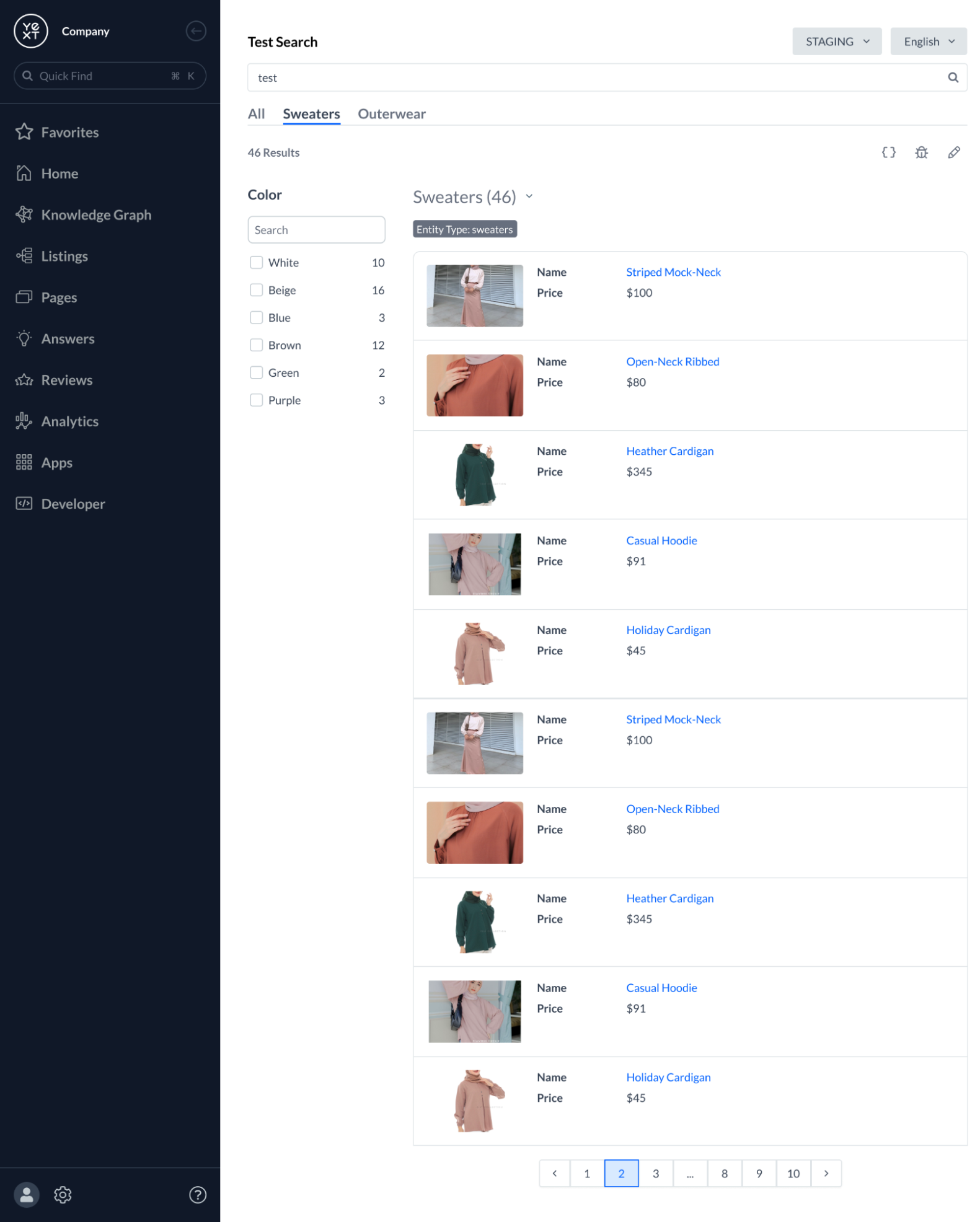
To turn this feature on in your account, navigate to Account Settings > Account Features and select Fall ‘22: Test Search Enhancements (early access).
To learn more about Test Search, visit our Navigating Search training unit.
VII. Basic Support for All Languages
Search can now be used in all languages. We have updated non-AI Search features to be compatible with any global language. These features include:
- Basic Text Search
- Phrase Matching
- Filter or Faceted Search
- Query Suggestions
- Synonyms
- NLP Filtering
- Query Rules
- Dynamic Reranking
Other Search features, such as Semantic Text Search and Extractive QA, are only available in select languages.
For the latest information on availability of advanced search features in specific languages, check out this reference doc.
VIII. Faster Model Deployments
We have implemented a new, more efficient model deployment process, in order to use updated AI models (such as Embedding, Extractive QA, Named Entity Recognition) for production experiences even faster than before.
We are continuously retraining our AI models, and this best-in-class machine learning infrastructure ensures that our users can take advantage of accuracy and search quality improvements from our latest models.
These backend model updates have been implemented, and improvements will be reflected in live search experiences.
IX. Query Suggestions 2.0
We revamped our Query Suggestions engine to offer the following benefits:
- Token prefix matching: When a user begins typing, autocomplete prompts will now be shown if they match with any word within the prompt, instead of just the first. For example, typing “pass” will now allow the popular query, “How do I reset my password?” to populate as an option for autocomplete, even though the word “password” was not the first token in the matched query.
- Faster indexing: Indexing will occur more frequently. This means that new popular queries and any changes to prompts in your configuration will be reflected in Query Suggestions in minutes.
- Saving by Configuration Version: Previously, Query Suggestions were only available on the Production label of your experience. Now, suggestions are saved for every configuration version. This opens up possibilities like updating and testing a new madlib prompt in Staging before deploying to Production.
- Bug fixes and reliability improvements
These improvements have been added to the Query Suggestions engine, so you should see these changes reflected in your account and on experiences today.
To learn more about Query Suggestions, visit our Core Configuration — Query Suggestions training module.
Pages
I. Pages CLI Improvements
With the Fall ’22 release, Yext has made it even easier for users to build a new site with the “Yext Pages New” command. This command helps users clone repositories, install dependencies, and configure GitHub remote repositories to get up and running on Pages faster. With these CLI improvements, local development only requires one command, allowing developers to start a project and begin building in seconds!

These improvements are available via the CLI, so you can start taking advantage of them today.
To learn more about how to get started with these commands, visit our Quick Start documentation.
II. Pages Streams v2 Support
In this update, significant performance improvements have been made to Streams; a critical utility that delivers consumer-facing Knowledge Graph data to Pages. Pages functionality has been optimized to support these updates. With this updated architecture, answers will experience a faster local development experience when fetching and previewing data locally. To learn more, check out the release note for Streams v2.
III. Point-in-Time Backups
New Point-in-Time Backups allow users to view and deploy a previous version of their website as it existed at any given point in the past (this includes both the template code as well as any pre-rendered Knowledge Graph data).
Users can preview their site as it existed in the past via any valid UNIX timestamp. In the event of a site outage or disaster scenario, this makes it easy for users to:
- Browse through a version history of their site for a point at which the site was in a clean state
- Publish/unpublish that version to production in seconds
Users can publish a backup directly from the Pages Deploys UI by clicking on the combo button in the upper right-hand corner. Once you select a date and time, the system will provide a UNIX timestamp, which can be used to preview your web pages as they existed at that time.
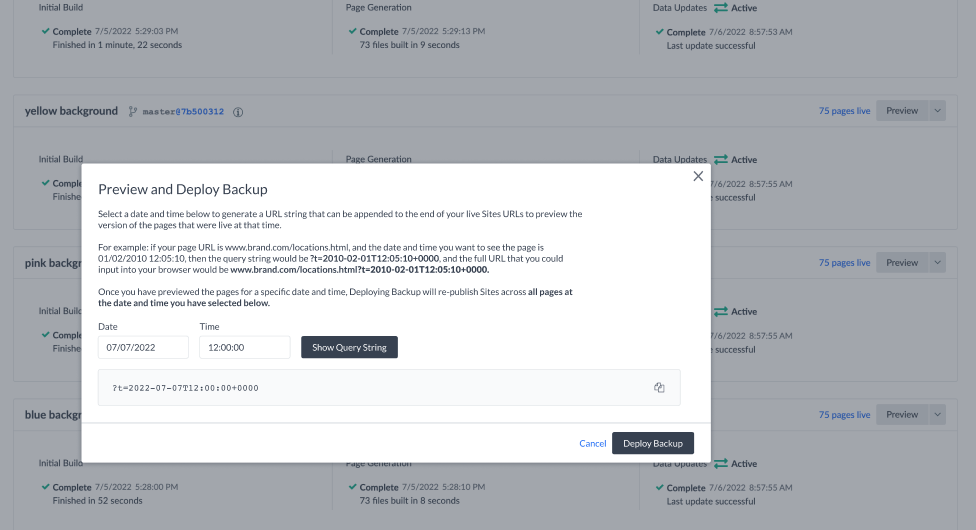
Note: You must be on the new Pages architecture to take advantage of Point-in-Time Backups.
To turn this feature on in your account, navigate to Account Settings > Account Features and select Fall ‘22: Point-in-Time Backups (early access).
To learn more about Point-in-Time Backups, visit our Site Backups documentation.
Analytics
I. Deprecation of Activity Log
In order to improve the way users can organize and manage Entity History within the Yext platform, we are deprecating the existing Activity screen in Analytics that includes the following event types:
- Profile Updates
- Reviews
- Social Posts
- Listings Live
- Publisher Suggestions
- Duplication Suppression
By migrating this data out of Analytics into each domain area, users will have better context when viewing Entity History and have access to more domain-specific information. If desired, users can also access the full Entity History via Logs API with the Fall ‘22 Release.
Note: The existing Activity Log and dedicated screen will not be officially removed from the platform until Spring ‘23. An advanced in-platform UI for Entity History and support for CSV exports for Logs API will become available in the near future.
II. New Size Limits for Reports API & Report Builder
We are implementing size limits to the Reports API and Report Builder to improve overall user experience. Previously, users may have had to indefinitely wait for their larger queries to crash before getting an error message or dealing with an incident. Now, users are notified earlier on in the process if we cannot support the size of their query.
The size limits are:
- 500,000 rows or 10MB for the Reports API
- 100,000 rows or 5MB for Report Builder
This means that any queries with results larger than the limit will automatically fail and return an error.
Note: In the future, we will add pagination to these tools to be able to support larger queries.
III. Deprecated Uber Links Analytics
As of the Fall ‘22 Release, Yext no longer supports Uber Links Analytics. The Uber Link Clicks metric has been deprecated, and users will no longer be able to access or track this action.
Connector
I. File Upload as a Source
Users can now upload Excel, CSV, and JSON files within the Connectors framework. This new source allows users to take advantage of modern UI and the data cleansing capabilities of the Connectors workflow prior to uploading the data to the Knowledge Graph. This also allows users to leverage the saved Connector configuration to easily update or ingest new content, rather than manually applying the data transforms every time.
With file upload as a new source, users can save time and benefit from the more robust feature set of Connectors.
Note: There are still feature gaps between File Upload via Connectors and the existing Entity Upload framework, so be sure to check out our documentation here for more information and best practices.
To turn on this feature in your account, navigate to Account Settings > Account Features and select Fall ‘22: File Upload Connector Source (early access).
To learn more about the File Upload Connector Source, visit our reference documentation.
Integrations
I. Publisher Network Updates
Unless noted otherwise below, new publishers added to the Yext Publisher Network will go live on December 15th, 2022.
New: 11880
Yext now supports listings on 11880. This submission-based integration supports name, address, phone number, business description, hours, and more.
- Territory: Germany
New: Brave
Yext now supports listings on Brave. This submission-based integration supports name, address, phone number, business description, hours, and more.
- Territory: Global
New: Goudengids.nl
Yext now supports listings on Goudengids.nl. This is an API-based integration that supports name, address, phone number, business description, hours, holiday hours, products & services, and more.
- Territory: Netherlands
New: Help.ch
Yext now supports listings on Help.ch. This submission-based integration supports name, address, phone number, business description, hours, social handles, and more.
- Territory: Switzerland
New: Pinkpages
Yext now supports listings on Pinkpages. This API-based integration supports name, address, phone number, hours, real-time updates, duplicate suppression, analytics, and more.
- Territory: Australia
New: Seccion Amarilla
Yext now supports listings on Seccion Amarilla. This submission-based integration supports name, address, phone number, business description, special offer, photos, hours, holiday hours, videos, and more.
- Territory: Mexico
New: Tandarts.nl
Yext now supports listings for dentists on Tandarts.nl. This submission-based integration supports name, address, phone number, business description, hours, photos, and more. In order to take advantage of this integration, dentists must fill out a KVK Number in the Knowledge Graph.
- Territory: Netherlands
Updated: Expanded Country Support
We now support listings in French Polynesia for the following publishers:
- Apple
- AroundMe
- Brownbook
- HERE
- Navmii
- Pitney Bowes
- TomTom
- Tripadvisor
- Where To?
We now support listings in Caribbean Netherlands for the following publishers:
- Brownbook
- HERE
- Yandex
Updated: Cylex
Yext’s integration with Cylex has new API endpoints which helps improve the reliability of the integration.
- Territory: Argentina, Australia, Austria, Belgium, Brazil, Canada, Chile, Colombia, Czech Republic, Denmark, Finland, France, Germany, Hungary, Ireland, Italy, Mexico, Netherlands, New Zealand, Norway, Peru, Poland, Puerto Rico, Romania, Slovakia, South Africa, Spain, Sweden, Switzerland, United Kingdom, United States, US Virgin Islands, Venezuela
Updated: ShowMeLocal Field Expansion
ShowMeLocal now supports the following fields:
- Price Range
- Instagram Handle
- FAQ
- Neighborhood
- Pick Up and Delivery Options
- Year Established
- Temporarily Closed
- Twitter Handle
Territory: Global
Updated: Facebook Migrating Classic Location Pages to New Page Experience
Facebook has begun migrating all classic location pages to the New Page Experience. Facebook has not provided a specific deadline, but all classic location pages will eventually convert into the New Page Experience. Please take note of the differences in functionality as a result of this change:
- Brand Structures. Facebook pages under the New Page Experience will not support brand structures. Facebook plans to add support for brand structures under the New Page Experience in the future.
- Note: Yext can still sync listings data, create posts on, and monitor reviews for pages under the New Page Experience, even if they are not part of a brand structure.
- CTAs. Facebook pages under the New Page Experience will not support CTAs.
- ECL Support. Facebook pages under the New Page Experience do not support ECLs. This will affect Menus, Products, Services, Events, and Bios.
- Additionally, Facebook will deprecate ECL support on classic Facebook pages on December 14th, 2022.
Stores Tab. Classic Facebook pages currently support a Stores Tab, which showcase any child pages linked to a brand page. Facebook pages under the New Page Experience will not support a Stores Tab.
- Additionally, Facebook is in the process of deprecating the Stores Tab from classic Facebook pages, although a cutoff date has not been set.
Given that pages under the New Page Experience do not support CTAs, ECLs, or the Stores Tab, those features should be considered deprecated with respect to Facebook once your classic location pages are converted to the New Page Experience.
IDs and URLs. Classic Facebook pages support both an ID-based URL and a Vanity URL:
- ID-Based URL: https://www.facebook.com/123456789101112
- Vanity URL: https://www.facebook.com/YextNewyork
Pages under the New Page Experience use a URL format that is different from the classic Facebook page ID.
- Note: If a page is a classic Facebook page or a page converted under the New Page Experience, both the existing ID-based URL and Vanity URL will automatically redirect to your New Page Experience page.
All changes noted above apply to all partners leveraging Facebook’s API and are not exclusive to Yext.
- Territory: Global
Updated: Safegraph Country Expansion
The integration with Safegraph now supports all Yext supported countries.
- Territory: Global
Updated: Vitals
Vitals now supports fields to add Videos for Carefinder customers.
- Territory: United States
Updated: WebMD
WebMD now supports fields to add Videos for Carefinder customers.
- Territory: United States
Updated: Bing
- New Attributes: Bing now supports more than 75 new attributes, allowing businesses to indicate whether a location is women-led, veteran-owned, has secondary hours, is permanently or temporarily closed, and more.
Social URLs: Bing now supports social URLs. This allows businesses to link Facebook, Instagram, and Twitter URLs to their Bing listings.
Territory: Global
Updated: MapQuest
MapQuest now supports all language profiles except for Japanese.
- Territory: Global
Updated: Oeffnungszeiten
Yext’s integration with Oeffnungszeiten is improving to a newer, more reliable API integration.
- Territory: Germany
Updated: ShowMeLocal
ShowMeLocal now supports the “Closed” flag, meaning businesses can indicate whether a location is permanently closed on ShowMeLocal.
- Territory: Global
Updated: Yelp
- ApplePay: Yelp now supports the payment option, ApplePay, for businesses that fall under any of the following Yelp parent categories:
- Beauty & Spas
- Event Planning & Services
- Food
- Local Services
- Nightlife
- Restaurants
- Shopping
- COVID Field: Yelp no longer supports the COVID Description field.
Virtual Restaurant Field: The ‘Virtual Restaurant’ field has been added to the Knowledge Graph to account for restaurant entity types that offer food delivery and takeout services but no dine-in options. This field is accepted and synced to Yelp as of Yext’s Fall ‘22 release.
- Note: If you are interested in syncing this new field with Yelp, please refer to the documentation for a list of prerequisites.
Territory: Canada, United States
Removed: AllergyEats
AllergyEats is now removed from the Publisher Network.
- Territory: United States
Removed: De Telefoongids
As of December 1st, 2022, De Telefoongids will be removed from the Publisher Network. This includes any syndicate sites of De Telefoongids, such as 1888, Vinden.nl, and Zoeken.nl.
- Territory: Netherlands
Removed: yellowpages.co.za
yellowpages.co.za is now removed from the Publisher Network.
- Territory: South Africa
II. App Directory Updates
All new Apps and App updates are automatically available in all accounts.
To view the full list of Apps that are available in your account click here .
Updated: Shopify Product Data Connectors App
We’ve launched a new and improved version of our Shopify Product Data Connectors. With this app you can keep your product catalog in sync with Yext by pulling in products, variants, and images in near-real time. These connectors leverage our Connectors framework, allowing you to customize, map, and transform your Shopify Products data which was not possible before. The old Shopify Product Catalog Sync App will be deprecated for GA of this release.
New: Eco-Movement Data Connector App
Add all of your Electric Vehicle charger and EVSE location information to your Yext locations. This app adds EV-specific fields for adding all of your data from Eco-Movement to your Location entities.
Updated: Result Action Analytics
You can now report on result action analytics within Yext. If you use Yext search in Zendesk, Freshdesk, Salesforce, or ServiceNow agent workspace you can now see how result actions (attach to case, insert text, copy link, etc.) are being used. This information can be used to further inform your brand’s content strategy.
Deprecated: Google Business Profile Sync App
With the release of our six new Google Business Profile connector apps, the original GBP Sync app is now outdated and will be deprecated on November 30. If you have used this app in the past, there is no need to make any changes on your end. If you plan on importing entities from Google, please use one of the new apps (e.g. Google Restaurant Connector, Google Hotel Connector) to do so. These new apps can bring in more fields than the original app, and are built within our Connectors framework, granting you visibility and flexibility in the data ingestion process.
Deprecated: Shopify Product Catalog App
This app is being replaced with our new and improved Shopify Product Data Connectors and will be deprecated on November 30. If you have installed this app before you wont need to make changes or move over to the new app.
Updated: Salesforce Reviews App
We’ve updated the app to allow users to filter by folder in your workflows.
Updated: Support Search Analytics Dashboards
Better understand and analyze your Agent Desktop, Case Deflection, and Help Site Search experiences with our Support Solution Search Analytics package, updated to include new metrics, dimensions, and insights.
New: Shopify Theme Frontend Integration Guide
Follow our integration guide to pull your Shopify product data into Yext and add a Search experience to your online store.
New: User History Component for Freshdesk
The Yext User History component reveals a requester’s journey through your Yext Search experiences, up until and after case creation. Arm your agents with this information so they can provide more relevant answers.
The component displays all of the actions a customer has taken in Yext Search. With this visibility, your agents can both communicate more efficiently with customers as well as identify documentation that hasn’t effectively answered the customer’s questions.
New: Google Business Profile Location Connector
You can now ingest Locations from your Google Business Profile using our new GBP Location connector built on top of the GBP source.
New: Google Business Profile Healthcare Professional Connector
You can now ingest Healthcare Professionals from your Google Business Profile using our new GBP Healthcare Professional connector built on top of the GBP source.
New: Google Business Profile Healthcare Facility Connector
You can now ingest Healthcare Facilities from your Google Business Profile using our new GBP Healthcare Facility connector built on top of the GBP source.
New: Google Business Profile Restaurant Connector
You can now ingest Restaurants from your Google Business Profile using our new GBP Restaurant connector built on top of the GBP source.
New: Google Business Profile Hotel Connector
You can now ingest Hotels from your Google Business Profile using our new GBP Hotel connector built on top of the GBP source.
New: Google Business Profile ATM Connector
You can now ingest ATMS from your Google Business Profile using our new GBP ATM connector built on top of the GBP source.
New: Drupal Document Connector
Sync all of your Drupal Document into the Yext Knowledge Graph with our new connector.
New: Drupal Image Connector
Sync all of your Drupal Images into the Yext Knowledge Graph with our new connector.
New: Drupal Video Connector
Sync all of your Drupal Videos into the Yext Knowledge Graph with our new connector.
New: Wistia Video Connector
Leverage our new Wistia Videos Connector to pull in your Wistia Videos into your Knowledge Graph to be used across Yext products!
III. Data Connector Sources
All new Data Connector Sources and Source updates are automatically available in all accounts. To view the full list of Data Connectors sources that are avaiable in your account, click here .
New: Google Business Profile Native Source
Our new Google Business Profile Native source allows users to visualize, transform, and ingest data all within our Connectors framework for a first-class experience. Users can directly authenticate with the API and link their Google Business Profile account to Yext via OAuth. With the source, users are able to pull in all relevant business/location details.
Once the data is pulled into the platform, users can leverage the advanced transform library to easily clean, format, and upload their data. If desired, users are able to set a regular cadence for an automatic data sync between Google Business Profile and Yext.
New: WooCommerce Native Source
Our new WooCommerce source and connector allow you to pull a diverse range of product data from your WordPress instance.
New: Storyblok Source
Now all customers using Storyblok as their headless CMS and seamlessly pull in all of their story content into Yext, allowing them to power their frontend website and search experiences with Yext.
New: Wistia Source
Easily retrieve your Wistia Videos using the Fetch Videos operation on our new Wistia source.
Updated: Hubspot Source
Updated the Hubspot source to use OAuth authentication for all operations to accommodate Hubspot’s deprecation on API keys.
We also added two additional operations for pulling in Website pages for Hubspot CMS customers and custom objects for Hubspot CRM customers.
Updated: Drupal Source
Updated Source: Our existing Drupal source now includes operations to pull in all standard Media Types (Documents, Images, and Videos) as well as Custom Media Types.
Platform
I. Scheduling License Unassignment
There is now functionality for users to schedule license unassignments and view the list of pending updates within a dedicated UI. Users now have the flexibility to set up a future license removal, when previously they were only able to execute immediate license removals.
For example, when you close a store location, it is best practice to continue to communicate the closure to the public for a period of time depending on the publisher. Yext now makes it easy to follow these best practices by using the new feature to schedule the license unassignment for a future date.
Your license unassignment updates that have not occurred yet are now available for you to view and cancel in the new Scheduled License Updates page.
As the most upvoted idea on the Hitchhikers Ideas board, we are so excited to get this new feature out to all users.


To turn this feature in your account, navigate to Account Settings > Account Features and select Fall ‘22: Scheduling License Unassignment (early access).
II. SSO From Yext Login Page
Users can now initiate single sign-on from the Yext login page. The login page offers a dedicated SSO login button alongside the Google and GitHub options to help users to easily navigate the login process.

This feature will be available starting on the General Availability Date, December 15th, 2022.
III. Search in App Directory
To improve the discoverability of apps within the Yext App Directory, we have added a search bar. As we continue to expand our catalog of turnkey integrations, this new feature will allow users to easily find the apps that they are looking for.
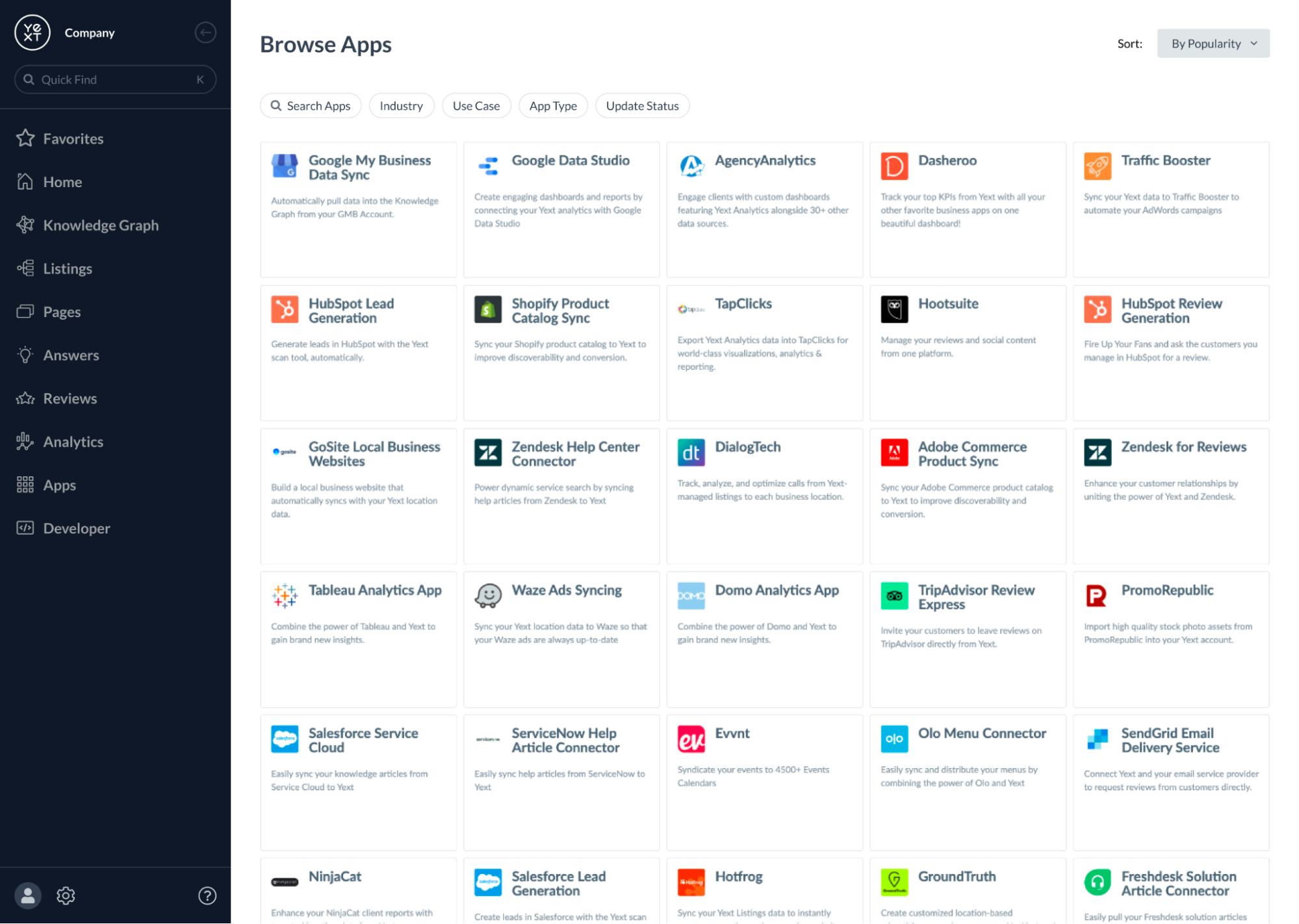
To turn this feature in your account, navigate to Account Settings > Account Features and select Fall ‘22: Search in App Directory (early access).
IV. Notifications Management Redesign
The Notifications Management UI within the Yext platform has been redesigned to help users to create and manage notifications more efficiently. This enhanced interface includes a new display for setting up notifications along with updates and additions to the Notifications Settings page.
The configuration options for creating and editing notifications are now featured in a dedicated full page display. Users can see the configuration options in a user-friendly and easy-to-navigate interface.
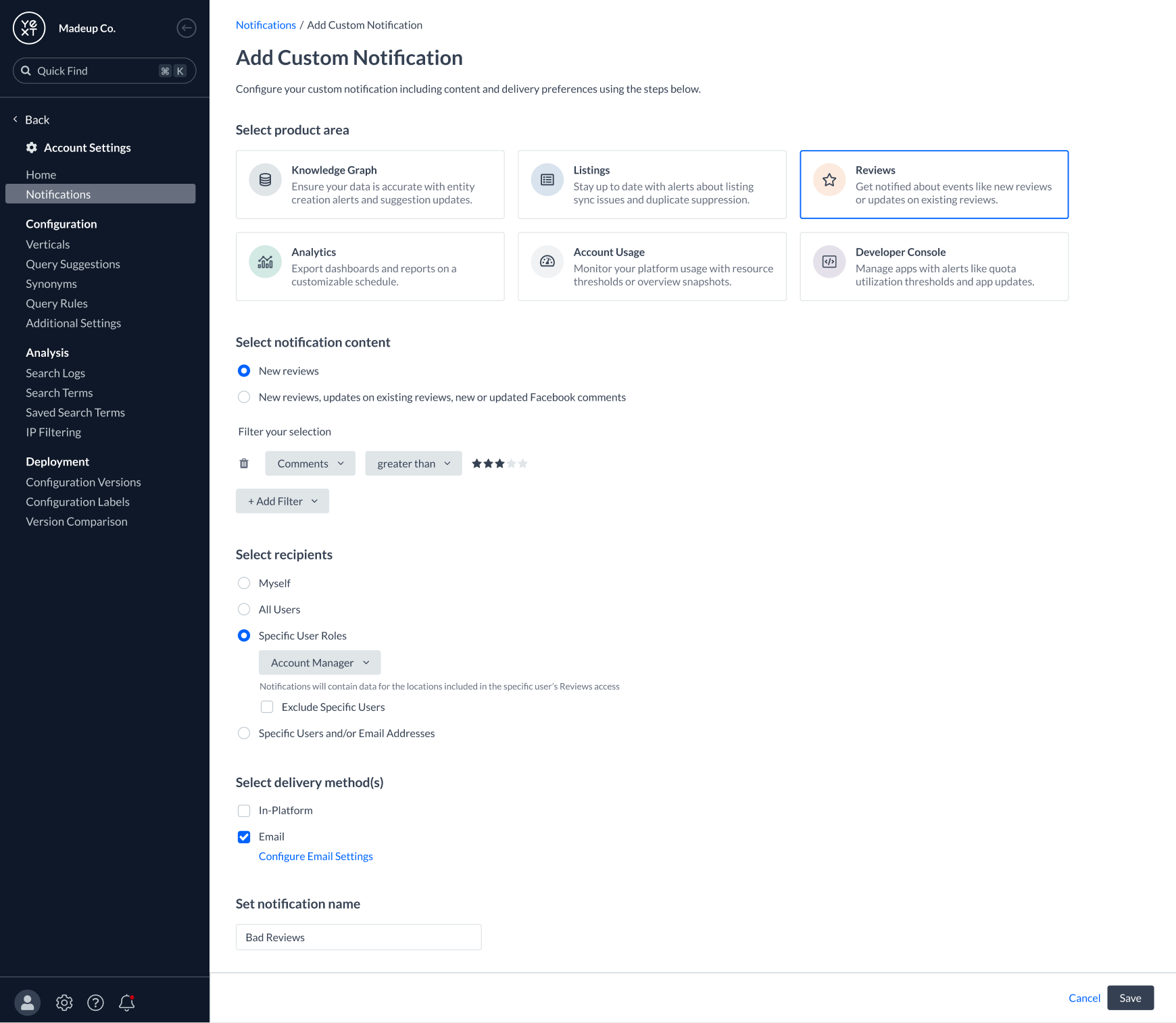
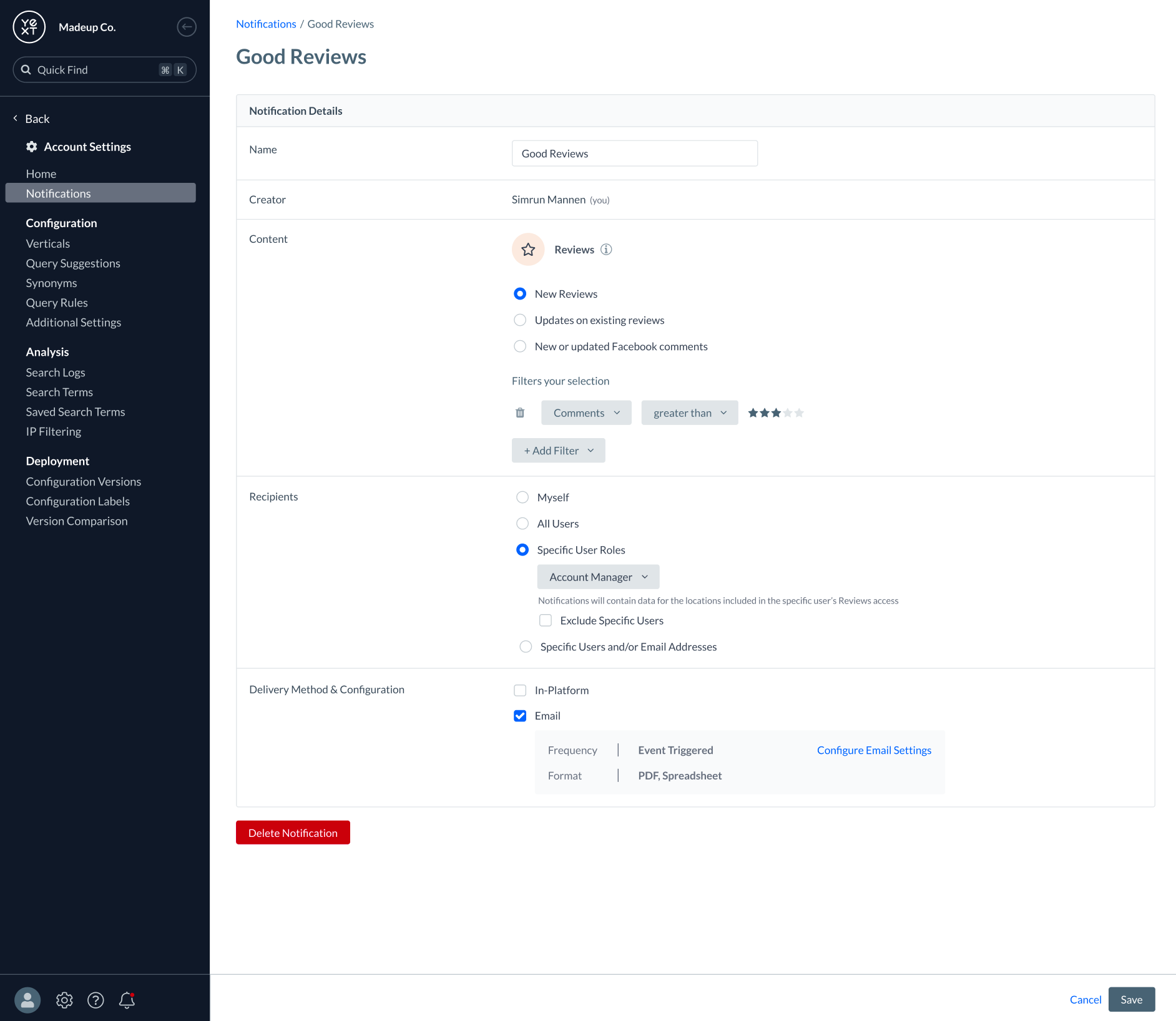
We’ve also upgraded the Notifications Settings page to add the following functionality:
- Visibility into all notifications where the user is either the creator or recipient
- Visibility into which user created each notification
- Ability to search and filter for notifications
- Ability to easily manage personal delivery preferences for notifications via toggle for in-platform and email delivery methods
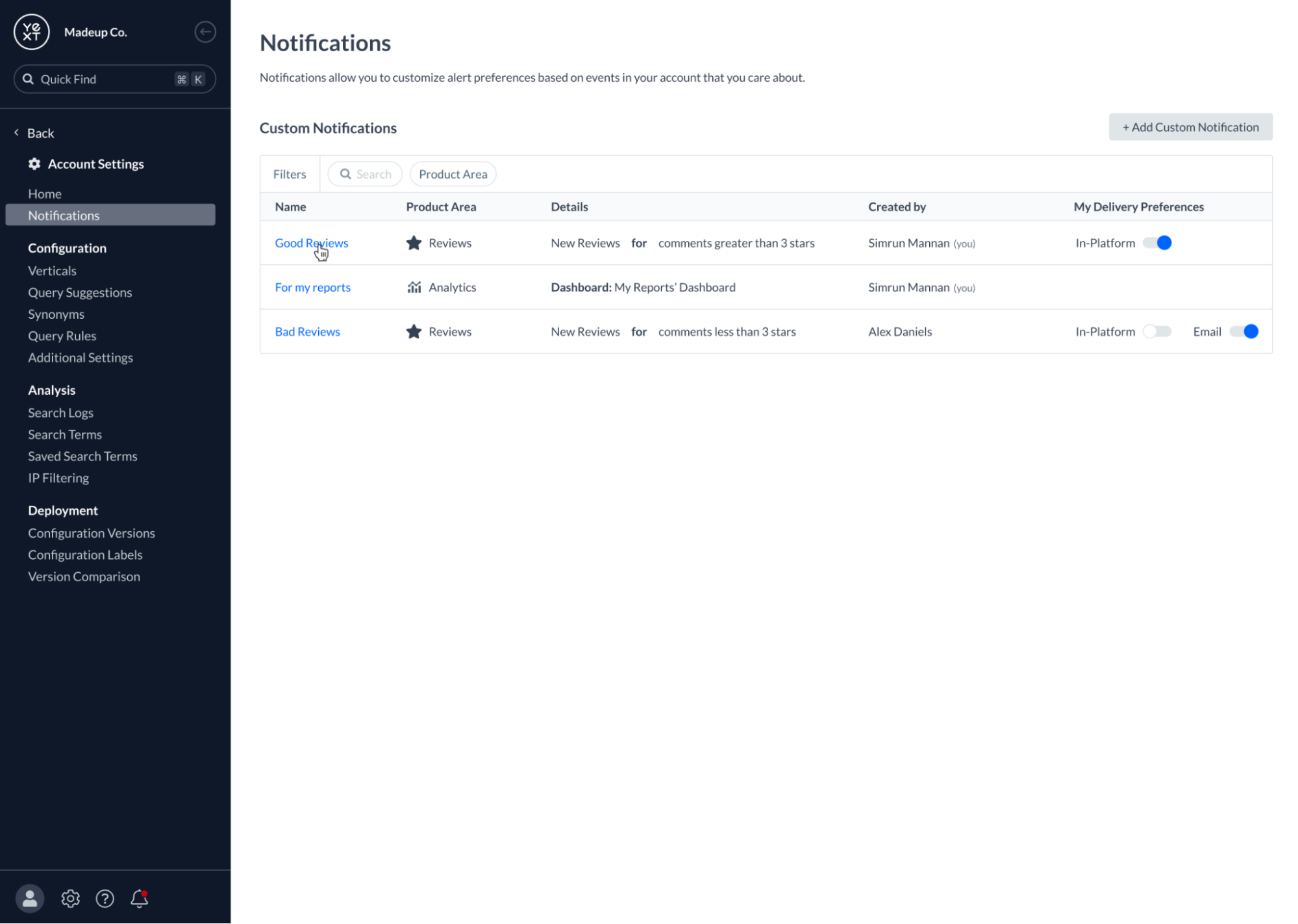
Altogether, these UI and UX updates make it easier than ever for users to create, edit, and manage notifications.
To turn this feature on in your account, navigate to Account Settings > Account Features and select Fall ‘22: Notification Management Redesign (early access).
V. Partner Portal Sub-Account Reports
With this release, partners can now export three reports (in CSV format) across all of their sub-accounts through the Partner Portal, rather than exporting reports for individual accounts. This enables partners to save time and conveniently pull everything they need in one place.
The three reports included in this release are:
- Google and Facebook Status - Report of the Google Business Profile and Facebook publisher statuses per location across sub-accounts.
- User Logins - Report of the count of logins and last login timestamp per user across sub-accounts.
- Content Fill Reports - Report of whether certain fields have content per location across sub-accounts.
This feature was automatically enabled in all Sandbox and Production accounts, so you can start taking advantage of it today!
To learn more about these reports, visit our Export Sub-Account Reports help article.
VI. Config as Code API
With the Fall ’22 release, we are launching a new way for users to programmatically manage their digital experiences.
The new Configuration as Code (CaC) REST API can edit any resource that is in our CaC system. This includes things like: Search experiences, site configuration, Connector configurations, entities in the Knowledge Graph, and more.
Now it’s even easier to create or update resources through an API. Previously, this could only be accomplished in the platform UI itself or through the command line interface in Admin Console.
For more information on the Review Submission API, visit our Documentation.
VII. Improved Streams Performance & Reliability (Streams v2)
Streams is the critical path for delivering data from the Knowledge Graph to Yext’s consumer-facing systems and powers custom-built digital experiences for customers. In this release, the team’s key priorities have centered around core architecture improvements that greatly increase the speed, efficiency, and reliability of updates propagated through Streams.
VIII. Rebrand Streams Endpoints/API/Webhooks to Content Endpoints/API/Webhooks
In this update, Streams Endpoints, Streams API, and Streams Webhooks developer tools have been rebranded as Content Endpoints, Content API, and Content Webhooks, respectively, to increase clarity across Yext consumer-grade APIs.
Note: Content Endpoints are the interface for external developers who are using Yext as a source truth for building consumer applications. Data can be fetched from these endpoints through the Content API or proactively sent via Content Webhooks. Content Endpoints are powered by Streams, the same way Search and Pages are powered by Streams.
| Old Name | New Name | Definition |
|---|---|---|
| Streams Endpoint | Content Endpoint | The configuration unit which provides access to the Content API and Content Webhooks. Consists of a Stream definition and a subset of fields which are indexed for querying via the Content API. |
| Streams API | Content API | The consumer-grade API which is used to make requests to Content Endpoints. |
| Streams Webhook | Content Webhook | Webhooks which are configured to send updates when documents included in a Content Endpoint definition are updated. |
| Stream | Stream (no change) | The core unit of configuration which includes a set of data (source, filter, fields, consumer). When initialized, the entire set of data which matches the Stream Definition is sent to the relevant consumer. Subsequent records are then sent for updates to records or new records which match the Stream definition. |
This rebrand has been implemented, so users will see the new terminology in materials and throughout content today.
IX. Content Endpoints UI
Previously, Content Endpoints (formerly Streams Endpoints) could only be configured via a technical interface (CaC). With this update, we have built a brand new UI for creating and managing Content Endpoints. Now, users can define and manage Content Endpoints via an intuitive user interface, rather than needing to know configuration as code and using the Admin Console or CLI. This update enables more customers to understand and leverage the Content API and Webhooks.
The Content Endpoints UI consists of two main screens:
- An overview table including information about existing Content Endpoints in an account
- An endpoint configuration UI that allows users to both configure new endpoints from scratch and edit existing ones
To turn on this feature in your account, navigate to Account Settings > Account Features and select Fall ‘22: Content Endpoints Configuration UI (early access).
To learn more about the Content Endpoints UI, visit our Content Endpoints Get Started guide.
X. Streams CLI Deprecation
With the re-architecture of the Streams system (as referred to above in Improved Streams Performance & Reliability (Streams v2), we have decided to deprecate the existing set of Streams CLI commands. Yext plans to implement command-line support in future releases that will be properly optimized for the architecture and use cases of Streams v2.
Hitchhikers
I. New Developer Homepage
The Hitchhikers team has completely reimagined their developer homepage to streamline the user journey.
Now developers can find guides, reference materials, easily spin up a playground account, and more, all from a single page!

Visit https://hitchhikers.yext.com/docs to check it out!
II. New Header and Footer Navigation
With the Fall ’22 release, Hitchhikers has streamlined the Header and Footer Navigation to make for an easier navigation experience and give power users a larger screen to take in all of the great Hitchhikers content.
Users will notice a new thin header and footer that bring more real estate to the page as well as a removed drop-down menu for some header navigation links to drive a more seamless experience to self-serve training and documentation.

III. Admin Code Snippet Deprecation
With this release the Hitchhikers team has deprecated the Admin Code Snippet page. For relevant content, please visit our updated Search documentation.
IV. Ideas Board in GA
The Ideas board is officially out of beta and generally available!
Hitchhikers Ideas is a platform for you to share your favorite product ideas or feature requests and to collaborate on others’ ideas through upvoting and commenting.
New features such as mobile support and email notifications make it easier than ever to get in touch with the Yext Product team.
The coolest part? The Ideas board is built on Yext’s Pages, Search, and Knowledge Graph!
Head to hitchhikers.yext.com/ideas to share your favorite platform Ideas or check out the ideas suggested by your fellow Hitchhikers.
V. Reference Improvements
New Reference Improvements make it easier than ever to find the reference content you are looking for. With right-hand navigation improvements and new next and back buttons you’ll spend less time looking for the right reference materials and more time building amazing experiences.
In addition, as part of the Fall ’22 release our reference content is now searchable!
Visit our Reference pages to start interacting with these features today!